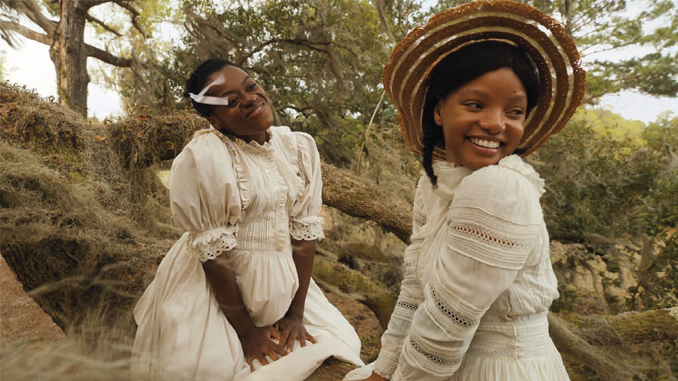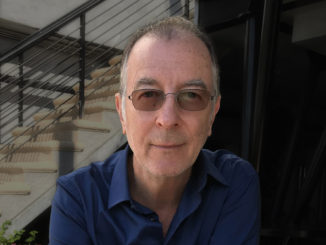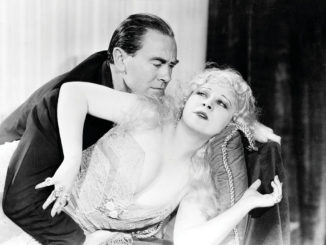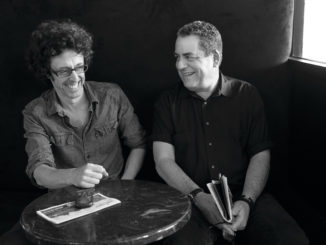
By Kristin Marguerite Doidge
Elegant and grounded: that’s how director Blitz Bazawule described his vision for the new musical film, “The Color Purple,” to picture editor Jon Poll when they first got started.
“I knew the film we were going to make would have to depart from the 1985 movie in terms of tone – and that we’d have to find our own visual language that would carry on sonically,” Bazawule said. “As we navigated the trauma and abuse in the story, we knew the fantastical elements had to come from reality.”
Oscillating between reality and fantasy, the post-production team – including Poll, Kheireddine El-Helou, additional and first assistant editor, Paul Massey, sound engineer, and supervising sound editors Julian Slater and Renee Tondelli – helped Bazawule strike a balance between style and substance as he took the helm of his first feature film. The coming-of-age period drama is based on the stage musical, the 1985 dramatic film directed by Steven Spielberg, and the 1982 novel of the same name by Alice Walker. The new version stars Taraji P. Henson, Danielle Brooks, Colman Domingo, Corey Hawkins, H.E.R., Halle Bailey, Phylicia Pearl Mpasi, and Fantasia Barrino in her film debut.

“I couldn’t have been luckier to have had as phenomenal a post team as I did,” Bazawule added. “Jon is one of the best. He’s cut tons of brilliant movies. Same was true for Julian and Renee. They all brought something special to the big, massive moments and also the intimate moments.”
CineMontage recently spoke with Poll, Slater, and Tondelli to learn more about how the post team worked diligently to capture the full range of emotions in all the moments of the film, scheduled for a Christmas release in theaters.
CineMontage: How did you first get involved and what was it like working on this movie?
Poll: My agent called me and said, “Warner Bros. wants you to meet the director for ‘The Color Purple.’” I said, “Call the studio and tell them this is a mistake.” I got on the phone and said the same thing to Blitz [Bazawule]. He laughed, and we had a two-and-a-half hour interview in the middle of a very busy workday on “Father of the Bride.” It was just a great first dose of Blitz, because Blitz does things in a more thoughtful, thorough way. He does everything that way.
Tondelli: I’d worked with Julian on a few movies that we were doing back-to-back, and I’d worked with Jon for 26 years. He asked me to help him do this movie. I said we should get Julian, and everyone fell in love with him. That’s how we got started as far as our crew went. Working with Blitz was just a wonderful experience for me. He’s a novelist, he’s a musician, he’s a painter, he’s a filmmaker, he’s a composer. He had such a clear vision of what he wanted, and it’s just so delightful to work with people like that because you can offer things and he’ll listen to them and say, “What if we did it like this?” He was so involved in the process for me on so many levels. He would spend mornings with Julian and then afternoons with me. It was just so great to have soup-to-nuts with your director before you go on the mix stage where he’s heard every single thing, he’s signed off on it, and he remembers.
Slater: He’s such a mature film director and I cannot wait to see what he does next. He had such a vision of taking the embryonic feel from the movie and the musical and kind of turning that into a new thing for a modern-day audience. He’s the best kind of director because he has a very clear vision of where he wants to go, but equally, he’s open to suggestions and understands ideas from other people can also be really useful.
CineMontage: How did he describe his vision for the film in terms of tone?
Poll: He said when he first heard about “The Color Purple” and read the script, he thought, “How do I wrap my head around this? Why are we remaking this movie?” What really drew him to it were Celie’s fantasies, which are very prevalent in the book right upfront. He said, “I see a lot of the musical sequences coming out of her fantasies.” The second musical sequence in the movie, “She Be Mine,” really sets the table. At one point, someone had suggested taking that out, but it gave you your way into the movie and understanding how far this could go. There’s a chain gang, women washing clothes, she’s singing about having her baby, and it really set the stage.

Another big part of pitching the fantasy was the scene with the giant gramophone, which he had done a pre-visualization for. In fact, he thinks that helped him convince Fantasia to do the film, because this was close to Fantasia’s life. This is really difficult territory. When she saw that, he said, she saw he had a different take.
CineMontage: What made the film’s sound unique as compared to the stage musical?
Slater: We obviously have many more tools in our arsenal, sound-wise, than what you get with a stage play or a live musical. And there’s a progression in the music in and of itself. It starts off as gospel, and then we go to blues, and then we have jazz. Blitz wanted these musical sequences to be very much part of the sonic fabric of the movie. We had fun using organic, natural sounds in certain ways. As Renee said earlier, you go from emotional highs to emotional lows quite quickly. We had a thing where using cicadas and insects that, on one hand, can be quite laconic and relaxing and a beautiful sound, to something that, if you overplay them, both in their intensity and in their level, they can go to this very intense, ratchety sound. You may notice in the movie that we have this constant theme when Celie is scared and oppressed and threatened, these insects kind of mirror her emotional state and they go from being quite a soothing, relaxing sound to quite an intense sound. There’s a moment where she’s giving Mister a shave on the back porch, and she’s obviously considering doing something a bit different to him than just giving him a shave. And there, we overplay the insects to quite a large degree to kind of amp up the emotional state that she’s in.

Tondelli: Julian and I wanted to try to get some recordings of the actual dancers doing the Foley, their steps on their own. We had told Blitz about this, and he said, “Oh, okay, that sounds good.” And then the producers we talked to said okay. So we went down the line and kind of talked to all of the people that could do this, and eventually, we had really good sound mixers: there was Steve Morrow and Richard Bullock and Nick Baxter, who was our executive producer, but who did a lot of the work with playbacks and earwigs [sound piece] and all of that. One night when they finished “Push da Button,” the song that Shug [Henson] sings inside the juke, Richard and Nick miked the whole place with booms on the top and then they had boom operators doing closeups, and they gave 55 earwigs to the dancers and did playback. And we got the best, just pure Foley. Of course, we enhanced it and things, but it was really nice to be able to get that and to also work early on with the production because sometimes you come on and it’s already been done, the production mixer is on another set. This way, we were able to actually work collaboratively back and forth, which I thought worked out really well.
CineMontage: What made this experience particularly memorable?
Poll: It was very meaningful for me to listen to Alice Walker take seven hours to read her 250-page book. I listened to it three times, and I heard so much subtlety about what the book meant to her. It was just in my head the whole time – that and Blitz’s point of view – his two key words to me in the beginning that were about tone were elegant and grounded.
What that meant to me is that we were not making a heightened musical. Even though the movie is heightened in how it uses fantasy, the movie has to work on an emotional level, which I’ll be honest, I’ve never cried so much watching a movie I’ve worked on, or even a movie I hadn’t worked on. I am just constantly moved by the film in different places. I was very aware that the movie had an unusual storytelling style, because most musicals don’t have this much story, but Blitz was great about coming and spending time with me while he was shooting. At the end of a shooting day, before a shooting day on a weekend, he would always watch whatever I’d assembled with me, and then we’d talk about it. He’d say, “I don’t want to just watch it on Pix and send you notes. I’m going to come in. We’re going to spend time together, we’re going to talk about things.”

Tondelli: The women had such a strong bond and they supported and celebrated each other at every moment. And it showed in post. It was such a joy to see that because you rarely get five or six women like that in a movie that are so devoted.
When Sofia’s in the gas station, we created what we called “Pleasantville,” when she pulls into the gas station and there’s ice cream and bells and chatter and kids laughing, and then as soon as she hits the mayor, everything goes silent. All you hear are the men pulling up in their cars, taunting her, her crying out, “Please get my children out of here.” And then we recorded her little son saying, “Mama, no!” Just as she was about to get hit and she got hit, and it just guts you. They were just like Herculean, these women. They just had this element of complete devotion to it.
When I recorded Colman [Domingo], who plays Mister, on the ADR stage, it was the scene where he’s crying in the field and he wakes up, and a very similar thing happened to him where he just couldn’t stop crying on the stage. He went into this catharsis of what this was like and what he felt. Blitz finally got up and put his arm around him and they held each other and he just kept crying. I’ve never seen that on a stage before.
Every time I see these scenes, as many times as I’ve seen them, it just makes me cry. I’ve never had this kind of experience before where you have everyone involved in a very global but small world. The post and the production people were constantly going back and forth. I was always talking to the choreographer and to the production mixers and to the producers, and we were all trying to make this thing as collectively as possible. It’s one of my favorite movies I’ve ever worked on.
Slater: For me, the thing about this movie that is perhaps a little different than a lot of the movies that I’ve worked on is it’s a very emotional movie.
We had one particular playback, I think it was the first full playback that we did of the movie with all the reels joined up and the lights, the end crawl finished, the lights came up, and you looked around the room and Blitz was very emotional because it was the first time that he had seen the culmination of his work.
Even from the get-go, “Mysterious Ways,” which is that amazing gospel song, it signals right from the beginning that you are going to be taken on a journey that is at times euphoric and highly emotional and rewarding, and at other times, there are a lot of serious things that happen within the movie and things that are quite depressing.
But the one thing about the movie is it spans a long amount of time, and I think it’s the first time I personally have worked on a movie that I would consider to be so epic – epic in its time span, epic in the story that Celie is going through from the beginning to the end, and epic in the emotional pull that this story has. It just reminds you how great cinema is and what movies can still do to you.
This interview has been edited for length and clarity.
Kristin Marguerite Doidge is the author of “Nora Ephron: A Biography.”





